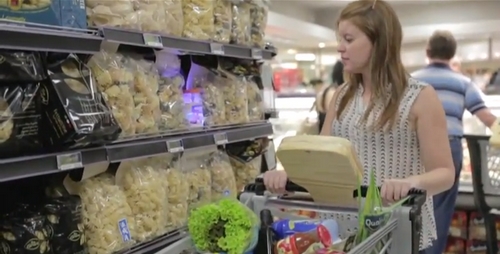In Brazil, Unilever‘s Hellmann’s mayonnaise division served up a new way to use radio frequency identification to market a brand. Deploying what has been ironically dubbed Near Food Communication—alluding to a type of RFID technology known as Near Field Communication (NFC)—Hellmann’s installed tablet computers and passive ultrahigh-frequency (UHF) EPC Gen 2 RFID tags to shopping carts, as well as RFID readers and reader antennas to shelves along store aisles. Consequently, if a shopper were to walk past the vegetable section, for example, a video of a salad with mayonnaise might begin playing on the screen. If the consumer found that recipe appealing, he or she could interact with the tablet’s touchcreen to find the necessary ingredients within the store, or share the meal idea with friends via social networks.
According Brisa Vicente, an account director at Brazilian advertising and marketing agency Cubocc, the project was a success. “In the first month, 45,000 people used the cart, thousands of recipes were sent and sales increased 68 percent—good news for the brand, and for consumers who have discovered a new way to buy and use Hellmann’s,” says Vicente, who served as the campaign’s director.

The campaign took place in a Pão de Açúcar (Sugarloaf) supermarket located in the Iguatemi shopping center in São Paulo.
“Hellmann’s is the first brand to install such technology,” explains Fernando Kahane, the marketing manager for Hellmann’s in Brazil. He describes the system as “a useful service and convenient to consumers, since 70 percent of decisions are made at the time of purchase.”
According to Vicente, Cubocc designed the RFID solution, consisting of a Smartrac UHF passive tag and a Samsung Tab 2 tablet with a 7-inch screen installed in each shopping cart, as well as Impinj Speedway Revolution fixed readers and antennas mounted along a store’s aisles. Server software, developed by Iceland 2nd Nation—which, like Cubocc, is owned by the Interpublic Group—communicated with the database containing products registered for the marketing campaign.
The software contained a record of each cart’s RFID tag ID number, Vicente explains. “As a shopper walked through the grocery store,” she says, “the RFID reader detected the presence of the tag within a radius of about 2 meters.”
Then, when that customer placed a jar of Hellmann’s mayonnaise into the shopping cart, the system suggested combinations with other products also available for sale at the supermarket, and displayed related videos as well.
Consumers had the option of sending a copy of the recipe via e-mail. When prompted to do so, the software stored the requested recipe. Every 10 minutes, Vicente says, all queued e-mails were then transmitted via a 3G connection.


